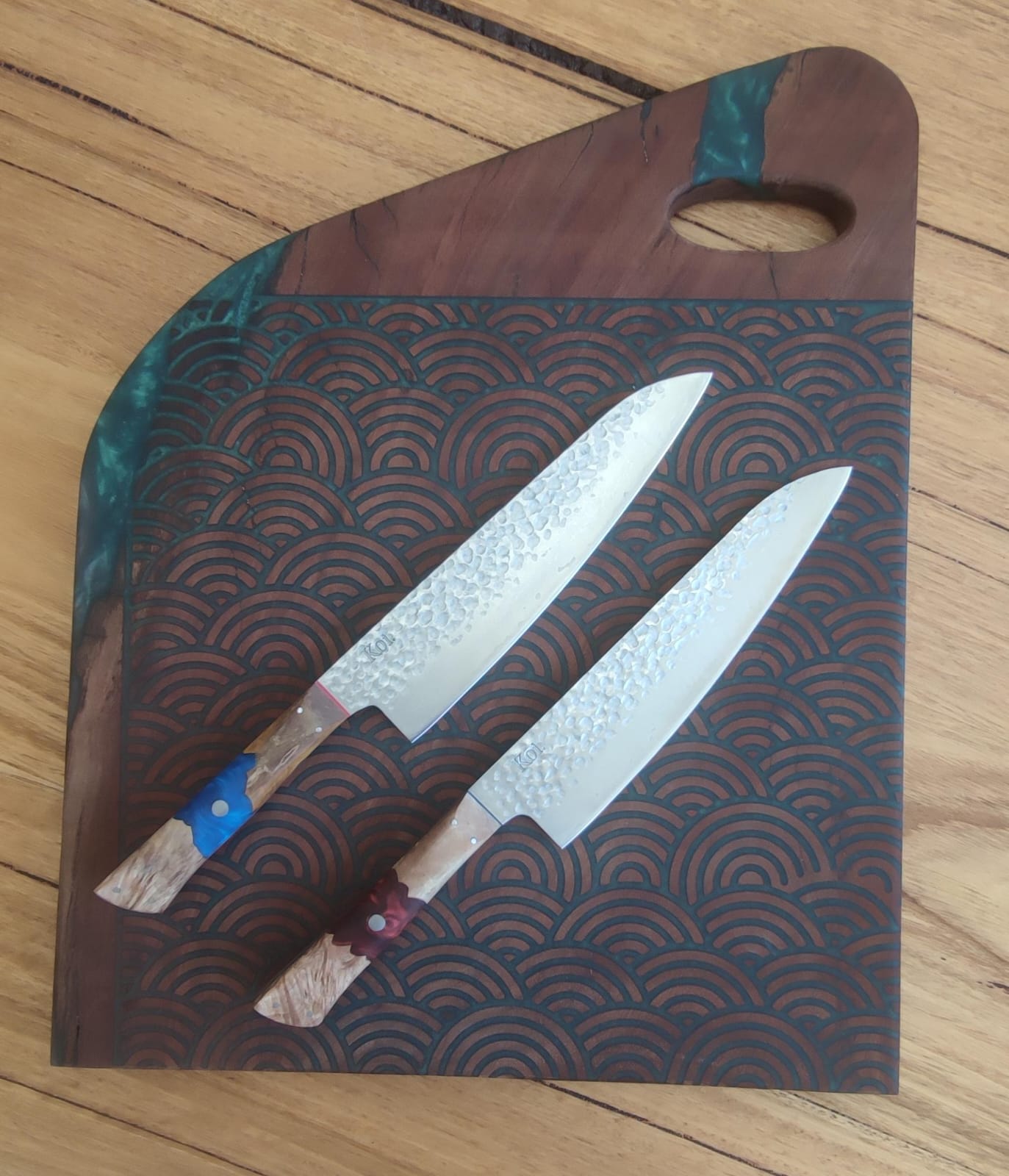Japanese knives are revered for their precision and artistry in the culinary world. Today, let's look at two exceptional blades: the Sujihiki and Kiritsuke. These knives, crafted through centuries of Japanese artistry, transcend mere tools to become extensions of a chef's craft.
In this post, we will guide you through the rich history, diverse uses, and unique characteristics of the Sujihiki and Kiritsuke knives.
Whether you're a seasoned chef or a home cook eager to elevate your kitchen experience, understanding these blades is a journey worth taking.
The History of Sujihiki and Kiritsuke
Origin and Evolution of the Sujihiki
The Sujihiki, born from centuries of Japanese culinary craftsmanship, has its roots in the ancient art of samurai sword making. Initially designed as a slicing tool for delicate sashimi, its long, slender blade ensured precise cuts, reflecting the precision required in Japanese culinary traditions.
Over time, it evolved beyond the traditional kitchen, finding its place in both professional and home kitchens worldwide.
Historical Context and Development of the Kiritsuke
The Kiritsuke, a knife with a distinctive pointed tip, originated as a multipurpose tool exclusively used by head chefs in Japan. Its unique shape allowed chefs to perform a variety of tasks, from slicing and dicing to intricate decorative cuts.
Historically, only the most skilled chefs were entrusted with the Kiritsuke due to its versatility and the respect it commanded in the kitchen. As culinary practices evolved, this exceptional knife transcended cultural boundaries, captivating chefs globally.
Sujihiki Knife: Uses and Characteristics
Slicing and Carving Applications
Picture effortlessly thin slices of sashimi or beautifully carved roasts – the Sujihiki excels in these delicate tasks. Its long, narrow blade ensures smooth, controlled cuts, making it an indispensable tool for any kitchen lover who appreciates the artistry of presentation.
Blade Profile and Length
Crafted with a slender profile, the Sujihiki's blade typically ranges from 9 to 12 inches. This elongated design reduces surface area resistance, allowing for seamless gliding through meats and fish. The result? Clean, uniform slices with minimal effort.
Handle Design and Materials
Handles, often the unsung heroes of knives, play a pivotal role in the Sujihiki's performance. They are designed with ergonomics in mind, ensuring a comfortable grip for extended periods of use. Crafted from various materials, these handles seamlessly blend durability and enhance the overall experience of wielding the Sujihiki in your culinary endeavors.
Special Features of Sujihiki Knives
What sets the Sujihiki apart? Many boast a double bevel, combining the precision of a traditional Japanese knife with the familiarity of a Western-style blade. Some feature a Granton edge – those subtle divots on the blade – reducing friction and preventing thin slices from sticking.
Kiritsuke Knife: Uses and Characteristics
Continuing our exploration into Japanese knives, let's delve into the captivating world of Kiritsuke blades.
Versatility in slicing, dicing, and chopping
The Kiritsuke is your kitchen's all-in-one maestro. Seamlessly transition from slicing delicate sashimi to dicing robust vegetables with this masterful knife.
Blade profile and unique shape
With a distinctive profile marrying the best of a chef's knife and a Yanagiba, the Kiritsuke boasts a graceful curve for rocking motions and a pointed tip for precision.
Handle design and materials
Crafted for balance, Kiritsuke handles feature ergonomic designs, ensuring comfort during prolonged kitchen sessions. High-quality materials contribute to both aesthetics and durability.
Special features of Kiritsuke knives
Kiritsuke knives are a symphony of craftsmanship from decorated Damascus patterns to hand-hammered finishes. Their multifunctionality and striking appearance make them a coveted addition to any kitchen arsenal.
Similarities between Sujihiki and Kiritsuke
When exploring Japanese knives, it's intriguing to explore the common ground shared by the Sujihiki and Kiritsuke. Both knives, born from centuries of Japanese craftsmanship, exhibit a finesse that transcends mere kitchen tools.
Shared Applications in the Kitchen
The Sujihiki and Kiritsuke, despite their unique shapes, excel in precision slicing. Whether delicately portioning sashimi or carving a roast, both knives demonstrate a remarkable ability to glide through ingredients gracefully.
Common Design Elements
Examining their profiles reveals shared features. Both knives typically boast thin, sharp blades that facilitate clean cuts. The elongated blades offer extended cutting surfaces, promoting efficiency in various kitchen tasks.
Overlapping Functions
In practice, you'll find an overlap in their functions. The Sujihiki, traditionally associated with slicing, demonstrates surprising versatility. Similarly, the Kiritsuke, known for its multi-functional prowess, can handle slicing tasks with finesse.
Differences between Sujihiki and Kiritsuke
Now, let's crack the distinct characteristics that set the Sujihiki and Kiritsuke apart, guiding your choice based on nuanced preferences.
Blade Shape and Profile Distinctions
The most noticeable difference lies in their blade profiles. The Sujihiki typically features a longer, narrow blade, ideal for intricate slicing. In contrast, the Kiritsuke's unique shape combines elements of a chef's knife and a traditional Japanese vegetable knife, offering a blend of slicing and chopping capabilities.
Specific Use Cases Where One Excels Over the Other
While both knives excel in various kitchen tasks, each leans towards particular applications. The Sujihiki's extended, slender blade is perfect for the precise slicing of meats and fish. On the other hand, the Kiritsuke's hybrid design makes it adept at both slicing and more robust chopping duties.
Variations in Handle Design
Beyond the blade, the handle design diverges. The Sujihiki often adheres to a more traditional, straightforward handle, emphasizing balance and control. In contrast, the Kiritsuke may feature a slightly curved, ergonomic handle, accommodating the knife's diverse applications.
Koi Knives: Crafting Exceptional Sujihiki and Kiritsuke
At Koi Knives, we take pride in crafting knives that stand out in both form and function. Our dedication to precision and quality is evident in every Sujihiki and Kiritsuke we create.
Materials Used in Crafting Sujihiki and Kiritsuke Knives
Sujihiki
Crafted from high carbon AUS10 67-layer Damascus Japanese steel, our Sujihiki knives offer a tough edge for precision slicing. The unique burl wood handles, while varying in appearance, provide a distinct touch to each knife, making them as unique as the daily weather.
Specifications:
- Blade Length: 260mm (10.23")
- Overall Length: 370mm (14.56")
- Blade Thickness: 2.8mm (0.11")
- Weight: 215g (7.58oz)
- HRC: 58-60
Kiritsuke
Our Osaka Collection features the K-Tip Kiritsuke with a hammered Damascus finish and a handle crafted from local hardwood and resin. This all-rounder, with its flatter profile and curved tip, excels at slicing and chopping, offering both aesthetics and power in one.
Specifications:
- Blade Length: 230mm (9.05")
- Overall Length: 380mm (11.02")
- Blade Thickness: 3mm (0.118")
- Weight: 228g (8.04oz)
- HRC: 60
Unique Features and Craftsmanship
Sujihiki
The Sujihiki is not just a knife; it's a symphony in the kitchen. Its length and sharpness allow for a single, smooth motion when slicing through large pieces of fish or steak. With a double-sided blade, it's more versatile than a Yanagiba, ensuring a clean finish to your dishes.
Kiritsuke
Our Hammered Damascus Kiritsuke, part of the Osaka Collection, is the kitchen's boss. Its flatter profile and curved tip provide exceptional leverage for slicing and chopping, making it a true all-rounder.
Reviews from Users
Our knives have garnered praise from both skilled chefs and home cooks alike. Users commend the exceptional sharpness, unique designs, and the perfect balance of our Sujihiki and Kiritsuke knives.
Conclusion
In revisiting our culinary journey, the Sujihiki's finesse in precise slicing contrasts Kiritsuke's versatile chopping prowess. Each a testament to the rich heritage of Japanese knife craftsmanship.
In every curve, every fold of steel, lies the artistry of a culture devoted to culinary excellence. Embrace the heritage and savor the precision—a Japanese knife is not just a tool but a true partner in your culinary journey.




